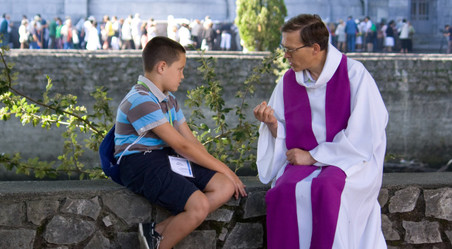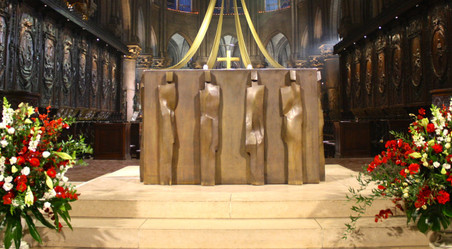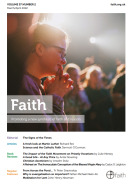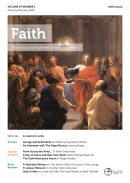Featured
Editorial
When the FAITH Movement began, in the 1970s, people were drawn to it because it ofered a coherent, uplifting and challenging message in the middle of post- hen the FAITH Movement began, in the 1970s, people were drawn to it because Vatican II confusion. It was standard at that time to hear many lamentations from the faithful, announcing that Everything was a Dreadful Mess, and claims that the fault lay with the Second Vatican Council, pointing to the exodus of priests and religious, proliferation of inane songs and antics in liturgies, and the inability of an ever-increasing ecclesiastical bureaucracy to ofer support for good catechesis. While most were prepared to acknowledge that the Council “didn’t intend any of this”, there was a tendency merely to lament what was happening – and so there was enthusiasm for any group that appeared to ofer hope. And meanwhile some wreckers were around, creating havoc with people’s faith – liberation theologians owing more to Marx than to the Gospel of Christ, crusaders for contraception who railed against Humanae Vitae and denounced the gentle Paul VI with a savagery that caused that good, wise and courageous man real sufering.
Karol Wojtyła and the importance of every human person

Karol Wojtyła – Pope St. John Paul II – accepted the classical defnition of the person, “an individual substance of a rational arol Wojtyła – Pope St. John Paul II – accepted the classical nature”, and brought to it all of the richness of contemporary developments in philosophy. Wojtyła does not satisfy himself with simply repeating the medieval interpretation of the defnition but takes it up afresh, augmenting and expanding it.
Grace – freely enfolded in God’s love

We use the word grace (χάριϛ/charis/ from which charisma comes) – Latin gratia– to express charm and beauty, but also generosity and the kindness of the e use the word grace (χάριϛ/charis/ from which charisma comes) – Latin gratia giver (‘grace and favour residences’). When we apply it to God, it speaks of his mercy and goodness: “a God of tenderness and of grace, slow to anger and rich in mercy” (Ex. 34:6).
Science, truth and God

Although few people are scientists or even that interested inscience, the infuence of scientifc thought has never been lthough few people are scientists or even that interested in greater. We take for granted that science is true. However, in the absence of a coherent Christian philosophy, some scientists have flled the vacuum, appointing themselves philosophers and declaring that God does not exist because there is no evidence for his existence.
A welcome in Manhattan

They had just fnished a “Baby Shower” party – the big sitting-room still had its there was more to come – a decorated announcement by the door welcomed a new resident, another pregnant girl. Meanwhile, there was warmth and laughter over evening snacks in the kitchen, lively talk and a relaxed atmosphere of friendship.
-
Editorial
Spring: looking forward
EDITOR
When the FAITH Movement began, in the 1970s, people were drawn to it because it ofered a coherent, uplifting and challenging message in the middle of post- hen the FAITH Movement began, in the 1970s, people were drawn to it because Vatican II confusion. It was standard at that time to hear many lamentations from the faithful, announcing that Everything was a Dreadful Mess, and claims that the fault lay with the Second Vatican Council, pointing to the exodus of priests and religious, proliferation of inane songs and antics in liturgies, and the inability of an ever-increasing ecclesiastical bureaucracy to ofer support for good catechesis. While most were prepared to acknowledge that the Council “didn’t intend any of this”, there was a tendency merely to lament what was happening – and so there was enthusiasm for any group that appeared to ofer hope. And meanwhile some wreckers were around, creating havoc with people’s faith – liberation theologians owing more to Marx than to the Gospel of Christ, crusaders for contraception who railed against Humanae Vitae and denounced the gentle Paul VI with a savagery that caused that good, wise and courageous man real sufering.
Exploring the background
Rarely heard was “How we got where we are” – so today it is worth exploring the background to the 1970s confusion. This necessarily involves a look at the tensions, debates and passions marking the era from Vatican I to Vatican II: a Church struggling with dramatic changes in European politics as the last vestiges of the ancien regime toppled. A sense of being embattled: a reliance perhaps on rules rather than answers to profound questions raised in a rapidly-changing world, a sense of the Church as a fortress rather than a Mother and teacher, a bleak landscape for Biblical studies. Academic rigidity: Scripture used chiefy as proof-texts for known certainties, neo-Scholasticism the imposed line in essays. And some injustice towards gifted theologians with fresh and rich insights.
The way ahead
But to this mix we should of course also add things that indicated the way ahead: Pius XII’s Divino Afante Spiritu and Mystici Corporis, the work of German-speaking theologians von Balthasar and (newly emerging) Ratzinger, plus the French Jean Daniélou and Henri de Lubac. It is worth noting that these last two were men of complete orthodoxy, passionately loyal to Catholic doctrine and moral teachings, unjustly marginalised in the pre-Council years, but magnifcently vindicated at the Council. They will have lasting infuence on the Church – but it is important to add that in the 1970s/80s they were roundly denounced as hopelessly “conservative”. Daniélou was treated with great unkindness by his own Jesuit brethren, even to the point of helping to spread untruthful stories about him following his death. (The FAITH Movement is quietly proud of having played its own small role in telling the truth and was privileged to be the publisher of one of Daniélou’s noted works on the Church).
Today any serious commentator must recognise the history, and then look beyond post-Council confusions and seek the authentic message of Vatican II: a message voiced by St John Paul II and Benedict XVI, both of whom played major roles at the Council. Today’s generation of Catholics is being infuenced by a much more nourishing diet than was available in the 1970s, and takes for granted the good things available: the Catechism of the Catholic Church, World Youth Day, St JPII’s Theology of the Body, the New Movements, Veritatis Splendor, Benedict XVI’s teaching on the relationship between faith and reason, and his emphasis on truth, beauty and a personal encounter with Christ, to name just a few. The Church has big problems – and is losing the once-Catholic heartlands of Europe – but she also has some new resources with which to face the future. And the staggering growth of the Church in Africa and Asia ofers a wider perspective to all discussions.
Beyond post-Council confusions
But there is much more to be done, and the FAITH Movement in this Spring of 2017 sees an increasing need for the specifc message of its New Synthesis of science and the Catholic Faith, with its dynamic of understanding that has fostered so many vocations to the priesthood and so much dedicated lay activity over the past decades. We mark our 45th anniversary this summer and will do so with gratitude to God and with a renewed commitment to the tasks ahead. FAITH has always had a forward-looking message and has never seen itself as part of that chorus of lamentation so dominant in the immediate post-Vatican II years. We did denounce the catechetical chaos, the absurdity of some of the new Religious Education material and, of course, the liturgical We love the Church, and have abuses. But we sought to take a postive stance. We were pleading for a decent translation of the Mass long before it became fashionable to do so (a famous feature in FAITH magazine pointed out a staggering number of serious mistranslations by ICEL), and were arguing that the vernacular should not wholly replace Latin in the liturgy (a good FAITH pamphlet put the case strongly). From the start our increasingly popular youth events had the Liturgy of the Hours, the Angelus, confession, Benediction and the Rosary when these were widely abandoned elsewhere. And we were prophetic in our grim predictions about the consequences of episcopal inertia over poor catechesis and inadequate (to put it mildly) support for Humanae Vitae.
Witnesses
We are glad to have been active in, and witnesses to, gradual and in some cases dramatic improvement in areas of Church life where we stood frm: most Catholic youth events now have the sort of liturgical and devotional style that at one time was almost unique to the annual FAITH summer gathering, and the new generation of priests has a vigorous approach to catechesis and to promoting the Church’s message on marriage and family life. But we are conscious that the growth seen in FAITH and in other New Movements has been in contrast to dramatic losses elsewhere in the western Church. From the 1990s there was increasing Papal encouragement for the New Movements in the Church, and we saw ourselves in a fresh perspective among them. We found we had, as it were, come of age – and since then the growth has continued, the FAITH Movement has fourished, and we look ahead. We love the Church, and have a confdence in the way in which she is always renewed. We seek to cultivate a love for the Church in the hearts of the young. We fnd inspiration in the vision of the Church ofered by Lumen Gentium at Vatican II, a Marian and maternal vision. Being a Catholic is not about rules, it is about truth and grace given by an incarnate God. Henri de Lubac loved the Church: “She summons all men so that as their mother she may bring them forth to divine life and eternal light” (Catholicism: 24, 1950). He taught, prophetically, the link between Mary and the Church: “Just as the maternal function of Mary is to give the God-Man to the world, so the maternal function of the Church, which culminates...in the celebration of the Eucharist, is to give us Christ” (The Splendour of the Church: 329, 1953). Hans Urs von Balthasar unfolded a profound understanding of the Mary/Church 3 bond, echoing de Lubac: “Mary begins by being the Mother, but at the Cross she ends by becoming the Bride, the quintessence of the Church” (To the Heart of the Mystery of Redemption: 53, 2005). And Joseph Ratzinger brings Biblical studies together with Mariology, noting that “She is the true Israel in whom Old and New Covenant, Israel and Church, are indivisibly one” (Daughter Zion: 43, 1977). In all of this we can see what formed John Paul II’s “Marian profle” of the Church in Redemptoris Mater. A new generation of Biblical scholars has made full use of the freedom opened up by Pius XII. Scott Hahn has founded a study centre specifcally to “promote biblical literacy for Catholic lay people and biblical fuency for Catholic scholars and clergy” – a fruit of Pius XII’s Divino Afante Spiritu and Vatican II’s Dei Verbum.
New generation
Vatican II’s emphasis on Scripture produced a richer and more nourishing diet from the Old and New Testaments at Mass. “A priest who celebrates Mass daily is required to proclaim much of the Bible in the course of a three-year cycle” (Scott Hahn). It also brought a fresh sense of confdence in using Scripture in evangelisation, as evidenced by the work of the New Movements in the Church. Thus Kiko Arguello of the NeoCatechemenate: “We were having a celebration of the Word with the travellers once a week...Among the poor, something was beginning to be created. What we now called the ‘tripod’...was born: the Word, the Eucharist, and the Christian community” (The Kerygma 2014: 62). The issue for the Church after 1870, the loss of the Papal States and associated troubles, was one of confrontation with the modern world and its huge challenges. What was to be done? T. Rowland writes “The response of Pius X in Pascendi Dominici Gregis (his 1907 encyclical against Modernism) was to try to avoid the iceberg of history. At Vatican II the majority decided that the iceberg, so to speak, could not be avoided: it had to be engaged. The names of Rahner, Schillebeecks, and Kung ...are now shorthand terms for one form of engagement, the names of Ratzinger, De Lubac, Wojtyła and von Balthasar, shorthand terms for another” (Ratzinger’s Faith: 148-149, 2008).
Engagement
We too seek to be part of that engagement. With the insights ofered by an exploration of a synthesis of faith and science, we respond to the call to evangelisation – from Paul VI’s Evangeli Nuntiandi, through the powerful and compelling calls of St John Paul and Benedict XVI to the plea of Pope Francis to take the message to the margins. FAITH is a movement born when man had just landed on the moon, when TV was in the frst fast-racing rush of its world domination in speedy communication, when the sexual revolution in the West was well under way and when the horrors of a possible 4 nuclear holocaust had frst established itself as part of world understanding. An era that called for a new synthesis. Quiet confdence And now, as in our early youth, we announce with quiet confdence that we need not be afraid. God’s original design for man is a great and glad one. In the era of the internet, post-modernism, “gender ideology”, global networking and the emergence of new biotechnology, the FAITH Movement is conscious of a sense of urgency in ofering its specifc message. In the 70s, our detractors – and indeed some of our supporters – spoke of us as reactionaries, gleefully announcing that we were “opposed to Vatican II”. We weren’t and aren’t. On the contrary – we saw and see that Council as opening up rich possibilities for the message that we ofer. The Church has the answers to the questions asked by men and women of the 21st century. There is work to be done and the FAITH movement is glad to be doing it. And now, as in our early youth, we announce with quiet confdence that we need not be afraid


















